
NINETEENTH CENTURY BRITISH SLIDE SIZES
Peter B. Paisley, Sydney, Australia
In late 1839, the Microscopical Society of London settled on two sizes - 3 x 1 inches and 3 x 1½ inches: thereafter, most UK slides met the former criteria. In Europe, a wide metric variety persisted until the 1880s, nor were equivalents exact (as anyone notices who tries to fit larger papered Bourgogne slides into British trays.) The Society supplied glass cutting apparatus for its members - presumably another stimulus to standardisation, but even in the UK, slides of different dimensions, particularly smaller ones, persisted in large numbers, until 1900 and after. Many factors governed variation, some of which I describe here. Thickness and degree of glass finish differed, as did material, which was sometimes cardboard, wood, or, rarely, metal.

An unusual 3 x 1 inch Norman slide: made from brass, painted black. Poulton and William Smith also occasionally used metal for 3 x 1 inch slides.
Economic and convenience factors
“Slider” mounts of the late eighteenth and early nineteenth centuries seem – to us - made from expensive materials: bone, ivory or ebony mounts were common, although some were of glass, or lighter wood. Until 1840, UK tax made glass expensive, so commercial glass mounts were often small and cover slips usually of mica. Sometimes two small glass slides were sandwiched, secured with paper or sealing wax, with specimens between the layers. The advent of reliable mountants, particularly balsam, made this extra glass use unattractive, and abolition of tax made glass cover slips a viable alternative to mica. Mica never disappeared, continuing in use today, mostly in microbiology. But economies of scale soon made glass yet cheaper, and 3 x 1 inch slides with glass cover slips mostly prevailed. Expense aside, transition from sliders by about 1830 was governed by convenience as much as by economics: slides were far less awkward to use, with advances in microscope design and the advent of adjustable stages.
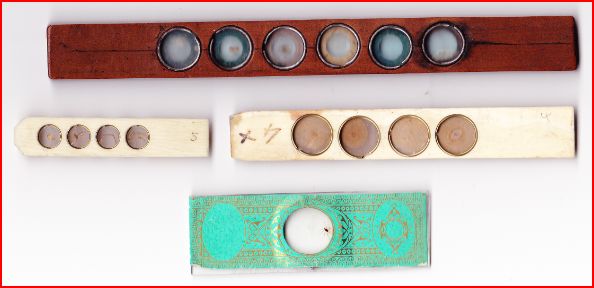
Various slider sizes. with a 3 x 1 inch glass slide for comparison. The wooden slider was made by the Hellstrom firm of Stockholm, the remainder are English.
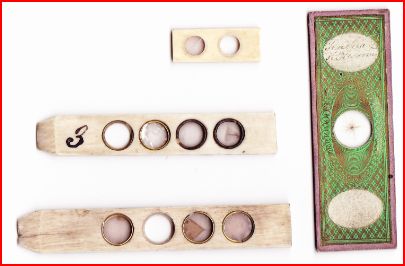
More sizes, with a standard slide for comparison. The smallest slider came with a Carey miniature microscope.
Not surprisingly, early commercial mounters favoured small glass slides during the late transitional period before 1840, before adopting Microscopical Society criteria: James William Bond is a good example, as in the slides shown below.
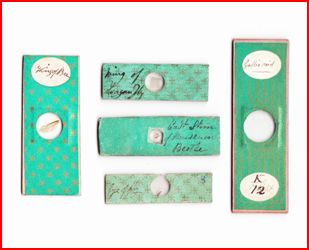
Bond illustrates both idiosyncratic variation and commercial factors. Only the later gallic acid slide on the right conforms to Microscopical Society specifications, with a glass cover slip, the rest employing mica. The commonest Bond slides to survive today are sized as in the eye of fly example (lowest middle above): presumably, these were his best money-spinners while glass tax was imposed.
Fitting cheap microscopes
Not everyone could afford large microscopes with adjustable stages, nor did everyone want them. Schoolchildren, and enthusiasts at all societal levels, often used small, or “pocket”, microscopes, which were cheap, so market factors favoured continued production of small slides. Small spring loaded microscope stages could not fit the larger size recommended by the Microscopical Society, and even the 3 x 1 inch formula was less easy to manipulate than smaller slides: the latter flooded the market, commonly being supplied with small instruments. C.M. Topping is regarded as a major influence in quick adoption of Microscopical Society standards. But Amos Topping, at least, was making small slides well after 1839, as was the Norman firm. The “German slides” sold by Smith and Beck were at first in the larger Microscopical Society formula: these were out of all proportion to their usual mount size, and at least one exasperated buyer nibbled such a slide down to small microscope size (with a pair of pliers by the look of it.) Some makers, with a nod to the standard 3 inch length, nevertheless cut their glass to varying narrower widths, thus both saving expense and continuing to cater for the small microscope market.
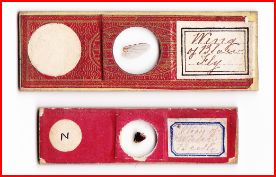
Insect parts mounted by Amos Topping on standard size and smaller glass

Frustration! The owner, perhaps of a pocket microscope, has
nibbled down this Smith and Beck German series 3 x 1½ inch
slide. Interestingly,
it was on-sold in 1867 by Wheeler, presumably
in its original format.

A second example of 'nibbling', courtesy of Brian Stevenson.

Yet more size variation: these slides measure 2 x ¾ inches. They are part of a set specifically made to fit a small compartment in the wooden box of a small English microscope. The slides, the microscope, and the box bear no maker’s name, but the handwriting on the slides is reminiscent of that on some slides by Tennant.
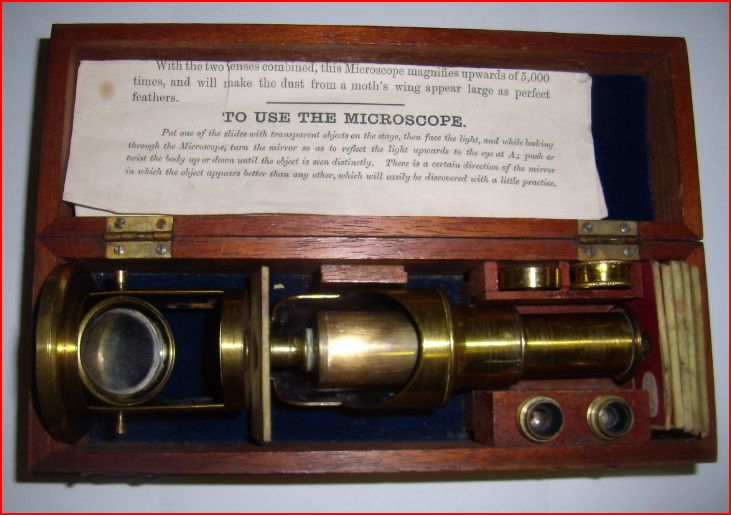

A small microscope, and an extract from its accompanying instruction leaflet. The unusual dimensions of the small red papered slides, in context, are self-explanatory.
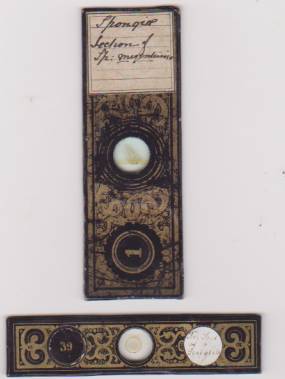
An interesting duo, in many ways. They are 3 inches in length, but 1 inch or ½ inch in width. Whoever made the papers probably also supplied glass cut to order. Unique in my experience, they came with separate number circles, stuck as desired on blank spaces on the paper - accounting for different specimens, bearing the same number, found on such slides. Recently some turned up from the Netherlands: all mine are labelled in English. I suggest that a South African origin may account for this.
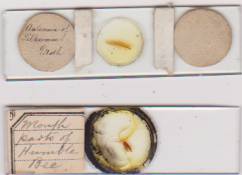
Small slides by Norman. One has the Norman label, the other has handwriting which seems the same as that on late Norman productions. Paper strips on the upper slide were possibly the owner's guides for placement on spring loaded small microscope stages.
Papering
“Wrap around” papering made glass yet more attractive to commercial mounters, since unfinished glass edges could be used. Mounters could cut their own slides, avoiding expense on expertly finished smooth or bevel edged material. Large businesses like Norman’s and Wheeler’s thus saved expense, until cheaper prices made finished unpapered slides relatively economic. Papering, too, favoured conformity to the 3 x 1 inch formula: one rarely if ever sees fully papered 3 x 1½ inch slides. As Davies (1863) comments, “[slides] are often covered with ornamental papers, which may be procured at almost every optician’s, at a cost little more than nominal, and of innumerable patterns and colours”. Some of these bore the opticians’ initials, like those issued by Smith & Beck or Amadio. Most doubtless provided a new burgeoning market for printers negotiating directly with mounters. Such additional decoration quite probably proved an even greater stimulus to 3 x 1 inch conformity than did the original Microscopical Society recommendation.
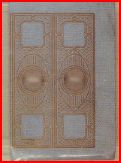
Wrap around papers, cut from a large sheet and bearing the Smith& Beck initials
Multiple trade factors thus conspired to consolidate hegemony for the UK 3 x 1 inch dimensions. Cross-channel rivalry however did not easily die off. The English market continued to sustain supplies of much smaller slides, complete with papers. While sheets of papers were available to fit “standard” slides, smaller papers could be made and applied by anyone, from any paper to hand: and continued profusion of small slides, particularly from France, often bore commercially printed papers. Throughout much of the century, the Bourgognes were probably the most prolific suppliers of small papered slides, on both sides of the Channel, and beyond.
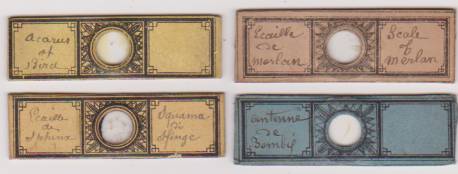
Familiar to most collectors, many slides like those above continue to turn up. These examples are labelled in French, English, French/English, and French/Italian.
Personal idiosyncrasy
Regardless of prevailing custom, individuals – both commercial and not – might choose any size they pleased. J.W. Bond has already been noted: small slides varied, particularly in length, and custom made boxes appeared to fit slides by some commercial mounters. Amateurs, of course, might cut slides to any size they liked, from whatever glass came to hand.
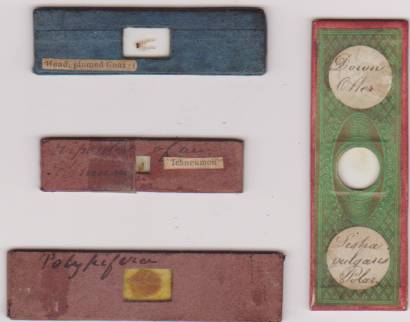
Whatever comes to hand! An unidentified mounter from the 1840s, with a standard 3 x 1 inch slide for comparison.
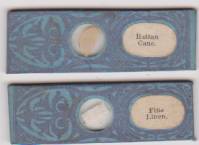
Same scale as above: this prolific commercial mounter from the late 1830s always used this glass size and paper pattern.
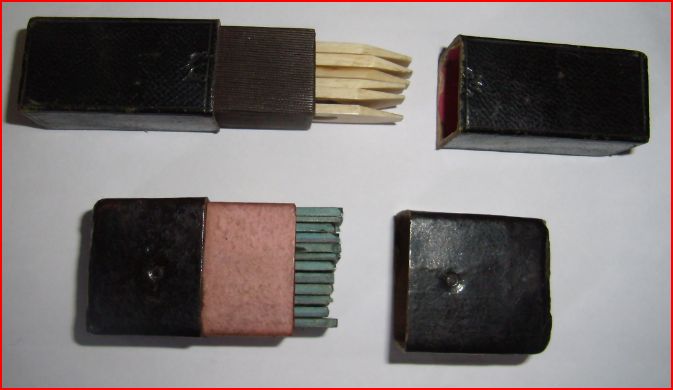
In the 1830s, transition from sliders to glass slides approached finality: commercial preparers issued sets of slides in custom made containers, as was the case for sliders; some mounters probably made both. Whoever made the slides in my previous illustration supplied containers to fit – illustrated above – as well as boxes holding 48. This canny professional used a consistent size slightly different from other mounters’, so the 48 slide boxes, made to fit only his, encouraged buyers to build up sets.
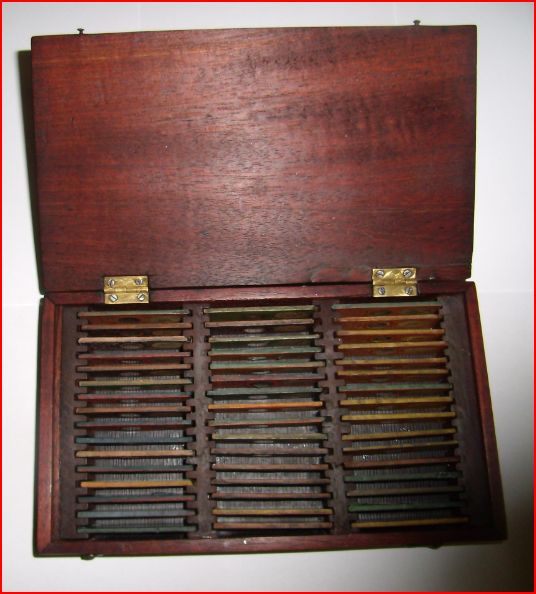
No fool, this mounter: in most cases, other small slides were a little too short, too long, or too wide, to fit properly into custom made boxes like this.
I cannot think of more individualistic presentations than those below. In size, style, and labelling they are like none others. Made in East Anglia in the early 1850s, they must be by a chemist or apothecary, since the labels – uniquely – often give concentrations in apothecaries’ weights. The preparer has not yet been identified.

It is difficult to imagine anything more striking than this trio of slides, with a standard 3 x 1 inch slide, beneath, for comparison.
Modernism: changing artistic taste
Long after paper served any functional purpose in securing coverslips, it continued in use for decorative reasons. Thomas Davies commented, “Many now use paper covers, about one and a half inches long, on the upper side of the slide only, with no other purpose than that of hiding the edge of the thin glass where it is united to the slide”. Later however “modernism” preached that form should fit function. Slides, as much as any other objects, reflected the newer design aesthetics. Abandoning elaborate decorative papers, if slides bore any embellishment, it was ringing. While this could be elaborate, it also had some function, preventing evaporation and leakage of mountant from the cover slip edge. Interestingly, the larger 3 x 1½ slides come closer to the golden mean than 3 x 1 inch slides: but the smaller formula, with ringing, seems to better match the clean minimalist forms of modernism – entrenching the 3 x 1 inch preference. Many mounters eventually eschewed even ringing, since well mounted specimens suffered little leakage.
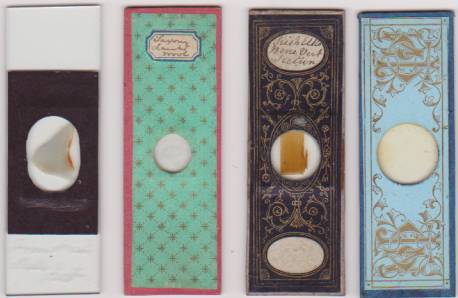
By 1860, as Davies observed, many slides bore non-functional papering over half their length. As he also noted, patterns of all kinds were also used, as in the starry paper above. In due course, far more elaborate designs emerged, like the two Norman examples above. Norman in particular could be even more flamboyant on the backs of slides.
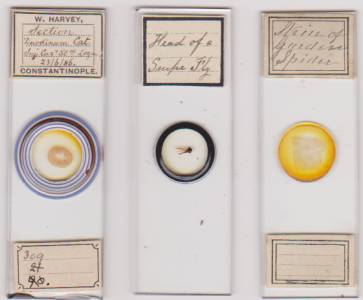
Reaction sets in: modernism rejected what was seen as the fuss and clutter of earlier Victorian taste. The urge to decorate however did not vanish with the end of papering: several mounters, like Harvey, above, used multicoloured ringing. More used plain black, and later, many abandoned ringing altogether, as in the Amos Topping slide above right.
Apart from changing stylistic taste, economics may have played their part in the plainer trend: commercial mounters increasingly competed in a shrinking market, due to increasing internalisation of slide making by universities in particular. Expense beyond the basics may have been unwelcome under changing circumstances – style, as well as the 3 x 1 inch format, was becoming standardised.
Ingenious pursuits
Unlike us, Victorians drew no hard line between entertainment and usefulness. The “magic lantern” had provided both drawing room and public entertainment long before the advent of glass microscope slides. Photographs of microscope mounts were “naturals” for the novelty seeking population as much as for the serious inquirer, as were slides bearing microphotographs. The latter largely offered depiction of scenery, architecture, or notable men, but also catered for those with a bent for mild pornography: and as a vehicle for espionage, the microdot flourished long before 1900.
Lantern slides were much larger than microscope slides, to fit projection apparatus. An enthusiastic public enjoyed remarkable microscopic demonstrations at the Adelaide Gallery, via the “oxyhydrogen” projection microscope, while deafened at hourly intervals by firing of a large steam gun. Lantern preoccupations seem to have got the better of one maker: the overall size makes the inappropriate dimensions of Smith & Beck German offerings pale into insignificance by comparison. I assume such examples are rare. E.M. Clarke’s premises were close by the Adelaide Gallery, with its wide variety of scientific curiosities, in an arcade off the Strand in central London, for many years from 1832. He designed all manner of apparatus, keeping in touch with his Irish contacts like Fitzgerald on the latest advances in physics: at times, he described himself as a “magnetician”, and, with others, pioneered production of the Daguerrotype in the UK. He also invented apparatus demonstrating the effects of polarised light: microscopic preparations were probably a sideline, and if the example below is typical, his forays into microscope slide making are moderately astonishing to modern eyes.
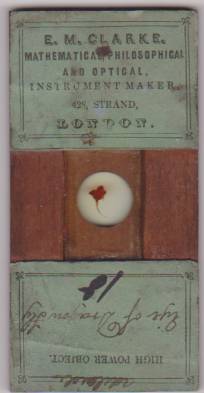
The glass slide, mounted within wood and partially obscured by labelling, is close to the later 3 x 1 inch size, but the overall dimensions are 4 x 2 inches. Ostensibly proposed as a microscope slide, the mind boggles at microscopists attempting to manoeuvre it on conventional stages, and it was probably made for the projection “oxyhydrogen” microscope.
J.W. Bond exhibited at the Adelaide Gallery, and co-operation between Clarke and Bond seems not unlikely, with Bond as expert in balsam preparation. The lantern slide below turned up in Ireland, and may be such an example: insect wings feature often in early Bond slides, and the handwriting on the wood is suggestive of Bond.
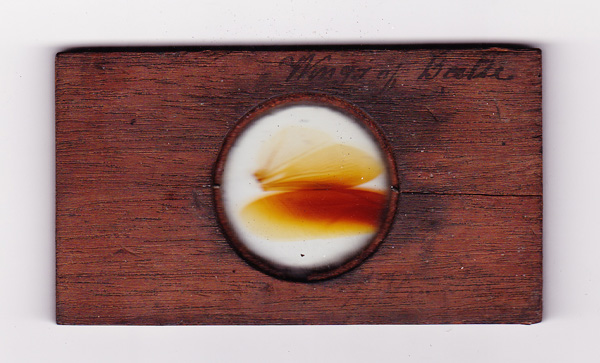
“Galleries of practical Science” like the Adelaide and others were popular successes until around 1850: after that the Adelaide became less a museum of technology and more like a circus, featuring inter alia dwarves and orchestral promenade concerts. Sliders for microscopes and multiple celled lantern slides show obvious design affinity, and butterfly wings were a perennial favourite with mounters. Examples such as the monster shown below may have been exhibited at venues like the Adelaide Gallery, with the public invited to view them via conventional lanterns, projection microscopes, or both.
.
The daddy of all sliders, measuring 10¼ x 2 inches
The examples above are probably from the late thirties. 3 x 1 inch slides by several preparers were set in wooden lantern frames in the 1840s, as in the example below.
In due course, less cumbersome slides and projectors were available: at least one mounter, Abraham Flatters, made projection slides from his histological mounts. Photography and microscopy went hand in hand, not surprising given mutual involvement in optics and lens development. Flatters’ projection slides could be shown to a large audience, backed up by microscope slides for individuals to peruse further, and commercial opportunities for mounters with photographic expertise were obvious.

Lantern slide of wood section, by Flatters & Garnett
Educational demands
By around 1900, there was near uniformity in glass slide size. Mass production of slides for hugely increased student numbers in biological and medical university departments, schools, and technical colleges, went with mass produced boxes to fit them. The vast majority of slides now conformed to the 3 x 1 inch formula: where exceptions occurred, as for instance with larger specimens for pathological study, the 3 x 1½ inch size usually prevailed. By the time of the First World War’s end, the era of slide size profusion had gone.
Envoi: a plethora of sizes
Standardisation, vis à vis manufacturing, has much to commend it. But the world of microscopy has lost something, if only for the collector. The array of sizes shown below is from an era long gone: the world is less interesting now.

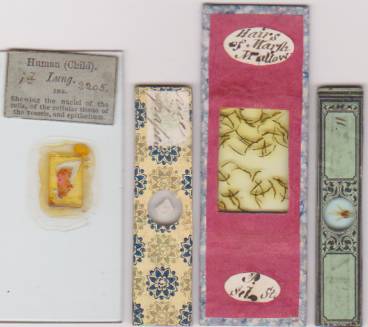
Slides on the left of each row conform to Microscopical Society norms. As for the rest, they illustrate but the tip of an iceberg of variation.
Sources
All slides shown are from my collection, except the Flatters & Garnett lantern slide, “snipped” from a recent eBay offering, and the starry papered lantern slide.
Thomas Davies (1863): The preparation and Mounting of Microscopic Objects, Robert Hardwicke, London, pp.8 & 27.
The illustration of Smith & Beck papers has been “snipped” from Bracegirdle’s Microscopical Mounts and Mounters (1998), plate 54.
See Richard D. Altick (1978) for a succinct account of activities at the Adelaide Gallery : Technology for the Million, New Scientist, June 1978, p.912.
Acknowledgement
Thanks to David Walker for his forbearance through my text corrections: Micscape’s “working versions” somehow always read differently from what one sees on one’s own computer.
Thanks to Peter Hodds for the image of the starry papered lantern slide.
Comments to the author will be welcomed.
Microscopy UK Front
Page
Micscape
Magazine
Article
Library
Published in the April 2011 edition of Micscape Magazine.
Please report any Web problems or offer general comments to the Micscape Editor .
Micscape is the on-line monthly magazine of the Microscopy UK website at Microscopy-UK .
© Onview.net Ltd, Microscopy-UK, and all contributors 1995 onwards. All rights reserved. Main site is at www.microscopy-uk.org.uk .